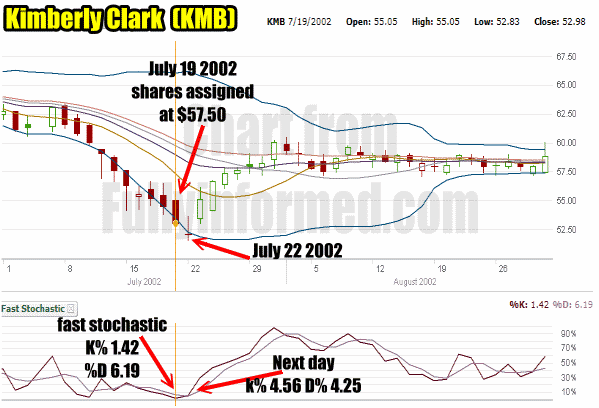 Collar Option or Married Put can be a very successful strategy if implemented the right way and for the right reasons. Before implementing any strategy, the importance of a having a plan is essential to financial success. No strategy will work consistently if not applied properly to meet goals established before the investment takes place. The interesting thing about the collar option or married put is that it is one strategy that probably allows for an investor to make a mistake with a stock and get out with limited losses.
Collar Option or Married Put can be a very successful strategy if implemented the right way and for the right reasons. Before implementing any strategy, the importance of a having a plan is essential to financial success. No strategy will work consistently if not applied properly to meet goals established before the investment takes place. The interesting thing about the collar option or married put is that it is one strategy that probably allows for an investor to make a mistake with a stock and get out with limited losses.
This strategy article is 3200 words in length and requires 10 pages if printed. Part of the article is available to all investors and the balance is for members.
Collar Strategy Saved This Investor’s Citigroup Stock Investment
For example in July of 2008 an investor friend purchased 1000 shares of Citigroup Stock. To him it made a lot of sense since the dividend was excellent and in the bear market the stock has fallen below $45.00 which he considered a steal since in 2007 it was trading for over $100.00 a share. With a discount of more than 50% in value he was thrilled. He put in place a Collar Option when he bought the January 2009 $40.00 put which cost him $3.90. I am sure you can see where this is going.
Citigroup Stock as everyone know collapsed and by January it had fallen to $8.00. This investor cashed out his shares for $8.40 and sold his puts for $32.75. Stock loss was $31.60. Collar option gain was $32.75 – $3.90 = $28.85. Dividends $4.80. Total Gain thanks to the collar option was $2.05.
Collar Option For Long-Term Dividend Investors
A collar option strategy can be used in different ways. One of the ways I use a collar strategy is to build a long-term dividend capture position in stocks. Dividends are the lifeline I cling to in good and bad times. I need the dividend to protect against inflation and provide income as I age. Dividends unlike bank deposits or bond yields can increase annually if I buy into the right company. A good example would be Johnson and Johnson Stock which when I first bought shares in 1988 was paying .03 cents each quarter. Today the dividend is .57 cents for a gain of 1800% in dividends over 24 years. This is why so many dividend investors purchase dividend paying stocks. I am not interested in just today’s dividend but future dividend increases as well.
The Problem With Dividend Stocks
The problem with dividend stocks though is that they rise and fall like any stock. I have never had a lot of problem with rising stock valuations and like all investors that is the goal of my investing. I want to earn the dividend and see a nice big capital gain somewhere in the future. However even dividend paying stocks get pushed lower in bear markets and large pullbacks.
To understand how I use the collar option or married put in my dividend investing an example is probably easiest to follow.
Collar Option or Married Put Goal
Many dividend investors buy a stock for the dividend and never look back. They do not want to sell, ever. I agree with part of that philosophy except I want to get my capital back faster and reinvest the same capital sooner in other stocks. To do this I use the collar option but with a covered call to help pay or finance for my collar option insurance. The goal then was to get the shares, pick up the dividend and have the stock paid for and my original capital returned in as fast a time as possible. The collar strategy can definitely assist.
Collar Option or Married Put on Kimberly Clark Stock (KMB Stock)
The trade I will discuss is my Kimberly Clark Stock trade. Kimberly Clark Stock symbol is KMB and it trades on New York. I first looked at KMB Stock in early 2002 and with stocks in a bear market I decided I wanted to own this stock for a long-term dividend investment. To get into the stock I sold puts at the $57.50 strike for several months and then on July 19 2002 the stock had an incredibly bad day and fell from 55.05 to close at $52.98. I decided to accept shares rather than roll the put contracts and was assigned at $57.50 for a total outlay of $57,500 less my income made through selling puts.
Timing The Collar Option
Investing successfully needs a strategy. Even a simple strategy like the collar option can make all the difference for consistent profit. My strategy was to use the Fast Stochastic Timing Tool to pick when to buy my collar option or married put and when to sell my covered calls to help pay for the cost of the collar option. I could have added other timing tools including the slow stochastic but my goal was to keep the stock, and pick prime days to sell covered calls and buy the protective put for the collar. I felt the fast stochastic was all I would need. I like to keep trades simple if possible and overall the collar option or married put is simple strategy.
The chart below is from that period in July 2002. On July 19 2002 options expiry, the stock had a terrible day falling 4%. For readers who are interested, in July 2002 the media was filled with stories of the end of America and the demise of the US dollar. They also were filled with panicked investors complaining about the collapse in stocks that July. Most didn’t know there was lots more downside to come.

Collar Option or Married Put Kimberly Clark Shares Assigned July 19 2002
Collar Option And The Fast Stochastic
On the day the stock fell, the fast stochastic reading was %K 1.42 and %D 6.19. In simple terms if %K is lower than %D, fast stochastic is signalling that the stock is going to move lower. However, the reading of 1.42 for K% is incredible low which normally means a bounce could be coming.
The next day the Fast Stochastic was %K 4.56 and %D 4.25. %K was higher than %D meaning the stock may move back up. It was only a small difference but this still told me there was a good chance of a bounce. You can see in the chart that the stock did recover over the next few trading sessions.
Use The Fast Stochastic To Pick The Best Time To Buy Your Put And Sell Your Covered Calls
I cannot stress enough that using a tool like the Fast Stochastic is important to pick the best moment for buying the collar option. This is because if I had bought my collar option the day after I was assigned shares the cost was very high. This was because the market was collapsing and investors were panicked. With my KMB Stock assigned at $57.50 by July 22 the stock was already below $52.50. The cost to buy a January 2003 $57.50 put was $9.25. The $57.50 January 2003 covered call could be sold for $1.10.
Remember that the Collar Option Is A Protective Put – Think Long Term
When I accepted assignment of the shares I wanted the stock. I wanted to start building a dividend income position in Kimberly Clark Stock. Yet when assigned shares, investors panic as they see the stock collapsing. It is important to forget this. Forget that the stock is falling. Remember the goal and the strategy. The goal was dividend income and to get my money back as quickly as possible. I never want to give up my shares. I want the dividend. The collapsing market will not impact my dividend unless Kimberly Clark goes out of business. I don’t believe that is going to happen. Therefore I looked to the fast stochastic to tell me when to buy that collar option and when to sell the covered call………. (balance of article is for members)
This strategy article is 3200 words in length and requires 10 pages if printed. The remainder of this strategy article is for FullyInformed Members. Consider becoming a member today.
Collar Option or Married Put For Long Term Dividend Investors
Members can sign in to the full members site here
Non-Members can join here, read members comments, view membership benefits
Disclaimer: There are risks involved in all investment strategies and investors can and do lose capital. You always trade at your own risk. The author assumes no liability for your investment decisions. Read the full disclaimer.
Internal Stock and Option Trades Links
END COPY
